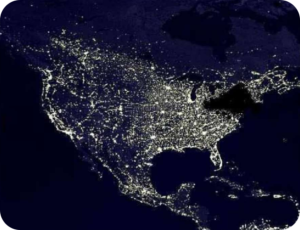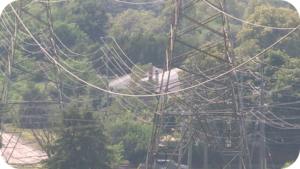
Do you remember what you were doing on August 14, 2003?
Well, if you were in Ajax, Oshawa, or Pickering, you were probably trying to stay cool. It was hot and humid with temperatures over 31°C.
That is until 4:09pm.
That’s when the power went out – literally – for 55 million people across the following areas:
- Ontario.
- Ohio.
- New York.
- Michigan.
- New Jersey.
- Vermont.
- Connecticut.
- Maryland.
Advantage Airtech ClimateCare takes a look back at what was – at the time – the second biggest blackout in world history.
What caused the blackout?
There are many (almost too many to count) factors which led to the power going out.
But here’s the short version.
As mentioned off the top of this blog, it was incredibly hot that day. Air conditioners were working harder than ever to keep people cool.
With all those home cooling systems running, extra demand was put on the power grid.
From there:
- Power lines were so overheated; they began to sag lower and came into contact with trees.
- A power station near Cleveland had a breakdown, straining already maxed out hydro lines.
- A transmission line in Dayton came into contact with a tree and got knocked out.
That last bullet point is big. When that power line in Dayton was knocked out, it also knocked out the ability of the local power company to monitor the system. They had no idea something was wrong.

Continuing the story:
- With one transmission line out of commission, other lines became overloaded.
- Two more lines sagged into trees and stopped working.
This was more than the system could handle. From there, circuits began to trip off. With no circuits to draw power, demand for electricity exceeded the available supply.
And then at 4:09pm local time, the blackout hit Durham Region.
The blackout’s impact in Ontario
In 2003, the population of Ontario was 12,243,758.
When the energy went out, 10,178,000 people were left in the dark.
That means 88% of people in the province were without power.
As a result, a state of emergency was declared in Ontario. Here’s what happened once the lights flickered out and the air conditioners stopped working:
- Traffic lights and subways shut down.
- Hospitals had to rely on emergency generators.
- Gas stations could not pump or sell fuel.
- Non-essential personnel were advised to stay home from work.
- Flights were grounded.

Here’s an interesting fact: The SkyDome (as it was called in 2003) roof stayed open – day and night – for 7 straight days in an effort to conserve power.
As for families, here’s what the blackout meant:
- NO WATER PRESSURE: Taps, showers, and other hot water solutions were useless because pumps could not transport water. In some instances, filtration systems also failed.
- FOOD WASTE: Due to lack of refrigeration, approximately $155,000,000 of frozen and perishable food was lost and dumped.
- COMMUNICATION: This was the time before social media. Cell towers failed and cell phones ran out of battery with no way to charge them. Radio stations went off the air and people lined up for hours to use payphones (remember them?).
- TRANSPORTATION: Many cars ran out of gas and were left at the side of the road. Meanwhile, people working had to walk home if it were possible.
Lessons learned
Perhaps the biggest positive to come from the Northeast Blackout of 2003 was that ordinary citizens took charge and became de facto traffic cops, helping cars navigate blacked out intersections.
Additionally, strangers became friends as people gathered under the stars on a clear night, shared stories, and gave each other a helping hand.

However, there were practical lessons too, such as:
- Although the power grid was updated after the blackout, so too has the overall demand for hydro. Laptops. Smartphones. Tablets. iPods. All these devices require electricity when being charged.
- Clean, renewable energy (solar, wind, water, etc.) is more important than ever. Not only is it better for the environment, it also places less strain and demand on the hydro system.
- As silly as it sounds, if certain utility companies regularly trimmed trees near power lines on a regular basis, the blackout may never have occurred. Remember, sagging lines coming into contact with trees were a big factor in the blackout.
Share your memories of the Northeast Blackout of 2003
Do you remember where you were during the blackout? How did you get through those first few days?
Share your stories with us. We’ll collect and share them in a future blog post.
Also, if you’re in the market for a new, energy efficient air conditioner, furnace, tankless water heater, or other home comfort product, we can help find the right one for you.
Contact us with your questions or comments. We’ll get back ASAP with the answers and info you need.








